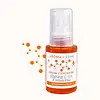What's inside
What's inside
 Key Ingredients
Key Ingredients

 Benefits
Benefits

 Concerns
Concerns

 Ingredients Side-by-side
Ingredients Side-by-side

Water
Skin ConditioningAscorbyl Glucoside 10%
AntioxidantGlycerin
HumectantSalix Nigra Bark Extract
Skin ProtectingSodium Hydroxide
BufferingSodium Levulinate
Skin ConditioningHaematococcus Pluvialis Extract
AntioxidantSodium Hyaluronate
HumectantSimmondsia Chinensis Seed Oil
EmollientAstragalus Gummifer Gum
Emulsion StabilisingLevulinic Acid
PerfumingSodium Anisate
AntimicrobialPhytic Acid
Polyepsilon-Lysine
Skin ConditioningTocopherol
AntioxidantHelianthus Annuus Seed Oil
EmollientWater, Ascorbyl Glucoside 10%, Glycerin, Salix Nigra Bark Extract, Sodium Hydroxide, Sodium Levulinate, Haematococcus Pluvialis Extract, Sodium Hyaluronate, Simmondsia Chinensis Seed Oil, Astragalus Gummifer Gum, Levulinic Acid, Sodium Anisate, Phytic Acid, Polyepsilon-Lysine, Tocopherol, Helianthus Annuus Seed Oil
Citrus Aurantium Dulcis Fruit Water
MaskingAscorbyl Glucoside
AntioxidantSalvia Hispanica Seed Extract
EmollientWater
Skin ConditioningPentylene Glycol
Skin ConditioningGlycerin
HumectantSodium Hydroxide
BufferingParfum
MaskingSodium Benzoate
MaskingSodium Hyaluronate
HumectantLevulinic Acid
PerfumingChondrus Crispus
MaskingSodium Gluconate
Skin ConditioningXanthan Gum
EmulsifyingCitric Acid
BufferingSodium Levulinate
Skin ConditioningLactobacillus Ferment
Skin ConditioningLinalool
PerfumingCitrus Aurantium Dulcis Fruit Water, Ascorbyl Glucoside, Salvia Hispanica Seed Extract, Water, Pentylene Glycol, Glycerin, Sodium Hydroxide, Parfum, Sodium Benzoate, Sodium Hyaluronate, Levulinic Acid, Chondrus Crispus, Sodium Gluconate, Xanthan Gum, Citric Acid, Sodium Levulinate, Lactobacillus Ferment, Linalool
 Reviews
Reviews

Ingredients Explained
These ingredients are found in both products.
Ingredients higher up in an ingredient list are typically present in a larger amount.
Ascorbyl Glucoside is a stable form of Vitamin C. It is created by combining glucose from starch.
When applied to skin, Ascorbyl Glucoside turns into Ascorbic Acid.
Ascorbyl Glucoside is an antioxidant. Antioxidants help fight free-radicals, or molecules that may damage skin cells.
It can help to reduce redness, improve skin texture, reduce the effects of aging, reduce the visibility of dark spots, and brighten skin.
Read more about other types of Vitamin C:
Learn more about Ascorbyl GlucosideGlycerin is already naturally found in your skin. It helps moisturize and protect your skin.
A study from 2016 found glycerin to be more effective as a humectant than AHAs and hyaluronic acid.
As a humectant, it helps the skin stay hydrated by pulling moisture to your skin. The low molecular weight of glycerin allows it to pull moisture into the deeper layers of your skin.
Hydrated skin improves your skin barrier; Your skin barrier helps protect against irritants and bacteria.
Glycerin has also been found to have antimicrobial and antiviral properties. Due to these properties, glycerin is often used in wound and burn treatments.
In cosmetics, glycerin is usually derived from plants such as soybean or palm. However, it can also be sourced from animals, such as tallow or animal fat.
This ingredient is organic, colorless, odorless, and non-toxic.
Glycerin is the name for this ingredient in American English. British English uses Glycerol/Glycerine.
Learn more about GlycerinLevulinic Acid is a fragrance that comes from the degradation of cellulose. It is a saturated fatty acid.
This ingredient is often used a building block for other compounds, such as in pharmaceuticals.
According to a manufacturer, this ingredient smells like caramel.
Learn more about Levulinic AcidSodium Hyaluronate is hyaluronic acid's salt form. It is commonly derived from the sodium salt of hyaluronic acid.
Like hyaluronic acid, it is great at holding water and acts as a humectant. This makes it a great skin hydrating ingredient.
Sodium Hyaluronate is naturally occurring in our bodies and is mostly found in eye fluid and joints.
These are some other common types of Hyaluronic Acid:
Learn more about Sodium HyaluronateSodium Hydroxide is also known as lye or caustic soda. It is used to adjust the pH of products; many ingredients require a specific pH to be effective.
In small amounts, sodium hydroxide is considered safe to use. However, large amounts may cause chemical burns due to its high alkaline.
Your skin has a natural pH and acid mantle. This acid mantle helps prevent harmful bacteria from breaking through. The acid mantle also helps keep your skin hydrated.
"Alkaline" refers to a high pH level. A low pH level would be considered acidic.
Learn more about Sodium HydroxideSodium levulinate is the a sodium salt of Levulinic Acid. If dissolved in an aqueous solution, the two ingredients become identical.
It is a skin conditioning agent, meaning it helps soften and hydrate your skin.
According to Cosmetic Ingredient Review, the highest amounts of sodium levulinate are found in mouthwashes at 0.62%.
Learn more about Sodium LevulinateWater. It's the most common cosmetic ingredient of all. You'll usually see it at the top of ingredient lists, meaning that it makes up the largest part of the product.
So why is it so popular? Water most often acts as a solvent - this means that it helps dissolve other ingredients into the formulation.
You'll also recognize water as that liquid we all need to stay alive. If you see this, drink a glass of water. Stay hydrated!
Learn more about Water